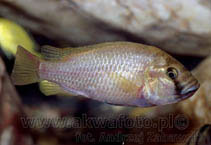| Family: |
Cichlidae (Cichlids), subfamily: Pseudocrenilabrinae |
| Max. size: |
15 cm SL (male/unsexed) |
| Environment: |
benthopelagic; freshwater, |
| Distribution: |
Africa: Lakes Malawi, Chiuta and Chilwa; Lower Zambezi, Buzi, Pungwe and Save River systems. |
| Diagnosis: |
Description: moderately slender-bodied; mouth small; frontal profile straight; caudal fin rounded; females smaller than males (Ref. 52307).
Coloration: males with several large orange egg spots in anal fin; lower parts of body and breast yellowish; body scales yellowish to pale orange with bluish to silvery margins; upper half of body somewhat darker than lower; rows of orange maculae visible in dorsal and caudal fins; 2 dark longitudinal bands o several dark vertical bars may occasionally be visible on the body; females with a plain, pale silvery to brownish coloration (Ref. 52307). |
| Biology: |
Occurs in vegetated areas in shallow water, but also found in rivers and streams around the lake. Feeds on invertebrates, algae, plants, small fishes and plankton (Ref. 5595). Ovophilic, agamous (Ref. 52307) maternal mouthbrooder (Ref. 6307, 52307). |
| IUCN Red List Status: |
Least Concern (LC); Date assessed: 22 May 2018 Ref. (130435)
|
| Threat to humans: |
harmless |
Source and more info: www.fishbase.org. For personal, classroom, and other internal use only. Not for publication.

